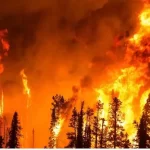Plants can guide us in detecting volcanoes, say scientists
As per the latest study by scientists, watching and studying the behavior of plants may hold the key to getting some clues about possible volcanic activity. For the same purpose, the researcher Robert Bogue along with this team of scientists at McGill University, began their doctoral studies on the ways to predict volcanic activity through the study of plants.
When it comes to traditional signs of the volcanoes acting up, like more carbon dioxide being released, it’s often tough to spot due to normal levels and the difficulty of reaching many volcanic spots. With this in mind, the scientists tried to find a link between how plants act and how volcanoes behave.
They focussed their attention on the satellite images of Yellowstone National Park continuously, from year 1984 to 2022. This park was chosen because it’s known for letting out carbon dioxide gases. Tern Lake, in the northeastern part of Yellowstone, became interesting due to its hydrothermal activity, spotted through changes in soil, dead trees, and unusual temperatures seen in satellite images.
The scientists found that as plants are greener, it indicates that they are growing more because of additional carbon dioxide in the atmosphere. Subsequently, when volcanoes increase their activity, the plants turn brown. Sulfur dioxide and high temperatures killed the plants, resulting in this brown color.
The study emphasizes the importance of noticing subtle changes in nature that otherwise go unnoticed by people. It stresses the importance of using advanced analysis methods to capture more detailed effects, adding a layer of understanding to our observations of volcanic behavior and plant health.
If you’re interested in delving deeper into this study, you can find the complete research in the Geochemistry, Geophysics, Geosystems journal.








